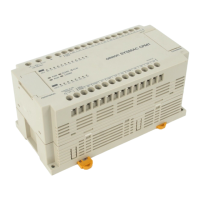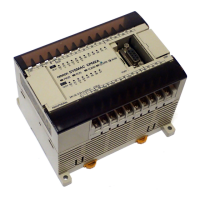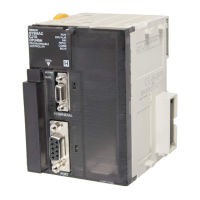496
7-1 PC Setup Overview
Parameter Function Normal application(s)
A:Hold areas H:Hold areas Specifies which bits are to maintain
status when power is turned off.
To extend the Holding Area beyond CIO
300.
R:Hold bits Specifies Racks or Masters (Remote
I/O Subsystems) that are to maintain
status when operation is stopped or
modes are changed.
To maintain output status for specific
Racks or Remote I/O Subsystems.
B:Startup
hold
K:Forced Status
(A00013)
Maintains the status of the Forced
Status Hold Bit when power is turned off
and on.
To maintain the status of bits forced ON
or OFF.
I:I/O bits (A00012) Maintains the status of the IOM Hold Bit
when power is turned off and on.
To prevent I/O status from being cleared
when power is turned on.
D:Power on flag
(A00011)
Maintains the status of the Restart
Continuation Bit when power is turned
off and on.
These parameters must be set to YES
when using restart continuation.
C:Startup mode Specifies the initial PC operating mode. To automatically start the PC when
power is turned ON. Set the mode to
MONITOR or RUN when using restart
continuation.
D:Startup processing Specifies whether the user program is
loaded from the Memory Card when
power is turned on.
To enable using a ROM Memory Card
without a backup battery.
E:I/O refresh Sets the refresh method to cyclic,
zero-cross, or scheduled.
To reduce the cycle time by using
immediate refreshing or to reduce surge
voltages for AC outputs.
F:Execute
control 1
B:Detect low
battery
Specifies detection of CPU battery
errors.
To disable detection when batteries are
not being used.
S:Error on power
off
Specifies if momentary power
interruptions are to be treated as errors.
To generate an error for momentary
power interrupts when they adversely
affect system operation.
T:CPU standby Specifies whether the CPU is to go on standby or start operation while initializing
the system or detecting terminators in SYSMAC BUS/2 Systems.
K:Measure CPU
SIOU cycle
Specifies whether or not the CPU Bus Unit servicing cycle is to be measured.
G:Execute
control 2
C:Execute process Specifies whether Peripheral Devices
are to be serviced synchronously or
asynchronously with program
execution.
To increase processing capacity
(speed) by using asynchronous
processing.
I:I/O interrupt Specifies whether higher-priority I/O interrupts are to be executed before a current
I/O interrupt.
D:Power OFF
interrupt
Specifies whether a power off interrupt
is to be executed.
To save system status when power
turns off.
A:Dup action
process
Specifies whether an error is to be generated when the same action is executed
simultaneously from two different locations in the program.
T:Step timer Sets the units for the step timer to 0.1 or to 1 s.
J:Startup trace Specifies whether a trace is to be automatically executed when power is turned on.
B:*DM BIN/BCD Specifies whether indirect addresses
are treated as binary (memory
addresses) or BCD (data area
addresses).
To enable indirectly addresses for the
entire DM and EM areas by using
binary addresses.
P:Multiple use of
JMP000
Specifies whether or not multiple JMP000 instructions can be programmed.
E:Comp error
process
Specifies whether I/O verification errors are to be fatal or non-fatal.
H:Host link Sets communications parameters for
the host link interface.
These settings must be made when
using the host link interface.
I:CPU bus link Specifies whether or not CPU bus links
are to be created.
To enable linking of two or more BASIC
Units.
PC Setup Overview Section 7-1

